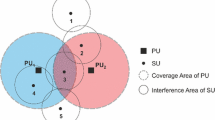Abstract
As ubiquitous networks evolve, various kinds of wireless networks will appear and coexist together with fixed networks. In particular, distributed control wireless networks will become increasingly important and will eventually cover broad service areas. Additionally, networks will rely on communications using multiple routes, such as multicasts and connections between wireless IP routers. However, simultaneous reconstruction of multiple multihop routes results in marked increases in network loads and wireless stations due to the movement of wireless stations. Here, a biologically inspired, autonomous, interference robust, multiple route reconstruction algorithm that employs only locally available information is proposed. This study evaluates the optimality of the input and demonstrates that the QoS of the proposed system improves when compared to route reconstructions based on existing routing protocols.
Similar content being viewed by others
References
Yoshida, S., Murata, H., & Hirose, S. (2000). Ad hoc wireless information networks. In Proceedings of JSPS-NUS/NTU seminar on integrated engineering, Singapore (pp. 213–219).
Tanaka A., Yoshida S. (2008) Optimization problem for minimizing density of base stations in multihop wireless networks. IEICE Transactions on Communications E91-B(6): 2067–2072
Royer E. M., Toh C.-K. (1999) A review of current routing protocols for ad hoc mobile wireless networks. IEEE Personal Communications 6(2): 46–55
Couzin I. D., Krause J., Franks N. R., Levin S. A. (2005) Effective leadership and decision-making in animal groups on the move. Nature 433: 513–516
IEEE Standard 802.11. (2007).
Li, Z., & Shen, H. (2008). Utility-based distributed routing in intermittently connected networks. In Proceedings of 37th international conference on parallel processing (ICPP-08), Portland, Oregon (pp. 604–611).
Pandey, M., & Zappala, D. (2008). Scalable multicast routing for ad hoc networks. In Proceedings of 5th IEEE international conference on mobile ad hoc and sensor systems (MASS 2008), Atlanta, Georgia (pp. 559–564).
Seidel, S., Krout, T., & Stotts, L. (2006). An adaptive broadband mobile ad-hoc radio backbone system. In Proceedings of 1st IEEE workshop on networking technologies for software defined radio networks (SDR 2006), Reston, VA (pp. 1–7).
Author information
Authors and Affiliations
Corresponding author
Rights and permissions
About this article
Cite this article
Tanaka, A. Biologically Inspired Multi-Route Reconstruction in Multihop Wireless Environments. Wireless Pers Commun 60, 809–825 (2011). https://doi.org/10.1007/s11277-010-9974-y
Published:
Issue Date:
DOI: https://doi.org/10.1007/s11277-010-9974-y




